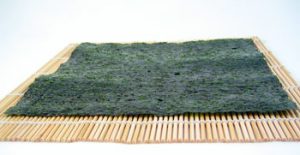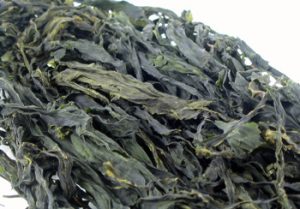Alaria is a seaweed used as a food item.It is a dark-green sometimes almost black colour, and has a milder taste than the seaweed the Japanese call “wakame.” It turns green when cooked. It grows with fronds up to 13 feet (4 metres) tall, and 10 inches (25 cm) wide, with a midrib. It doesn’t…
Seaweed
Arame
Arame is a variety of seaweed used in Japanese cooking. The leaves of the weed, when cooked, have a mild, sweet taste. It is steamed for use in soups and salads. The plant prefers growing in cold water. It has large, thick, dark brown leaves. The leaves are cut into thin strands when being processed,…
Dulse
Dulse is edible seaweed. In general, dulse has flat, tough and leathery, purple or deep-red broad leaves (called “blades”) with jagged edges. The blades grow up to about 50 cm long (24 inches) and 20 cm wide (8 inches), depending on the variety. Dulse is an acquired taste, having a salty, strong seashore flavour, as…
Hon Dashi Recipe
A Japanese stock recipe. You can make two broths from the seaweed and the tuna.
Ito Wakame
Ito Wakame is a long, thin seaweed that can grow up to 5 feet (1 ½ metres) long. It is cultivated and used in cooking in Japan and Korea. When the seaweed is harvested, it is washed in salt water, then laid out to dry in the sun with charcoal sprinkled over it. The charcoal…
Kaipen
Kaipen is dried, deep-green sheets of an algae called “kai” in Laotian (sometimes spelt “khai” in English.) It’s made from freshwater algae, so it’s not seaweed, and therefore not as salty as seaweed, and has no fishy notes. The algae is harvested November through to February. It is let dry, then is mixed with tamarind…
Kombu
Kombu is an edible seaweed popular in Japan, and particularly in the Okinawa region. It is a kelp, with thick, wide leaves several yards (metres) long. They are dark brown to greyish-black; the darker the colour the better. The kelp is harvested, sun-dried, and folded into sheets. When dried, a whitish powder appears on it….
Kombu Dashi Recipe
Kombu Dashi is a simple Japanese stock based on seaweed. It is often used with meat or fish dishes.
Nori
Nori © Denzil Green Nori is the generic Japanese word for seaweed used as a food item. There are actually several different kinds of seaweed that can be used, and the Japanese do indeed distinguish between them, as well as distinguishing based on any processing methods applied to the seaweed. Nori was first harvested from…
Purple Laver
Purple Laver is an edible seaweed that is very dark yet somewhat translucent when dried. It grows 1 to 2 feet (30 to 60 cm) long and up to 8 inches (20 cm) wide. It anchors itself by attaching itself to rocks. In Britain, it is eaten more in Scotland. Cooking Tips It can be…
Rockweed
Rockweed is a seaweed that is not eaten. Instead, it is used as a “cooking tool.” Particularly, it is used as a bed in clambakes. The moisture from it provides flavoured steam for cooking. The plant is a slow-growing perennial with dark green or brown fronds. The fronds have bubbles (technically bladders) in them. The…
Seaweed
Seaweed is a plant that is a member of the algae family. It can grow in saltwater and in brackish water. Many types of seaweed are harvested as food, and used in various forms. Seaweed overview Seaweed mostly grows near the shore or on coral reefs. How deep it grows depends on the variety. The…
Wakame
Wakame © Denzil Green Wakame is a type of seaweed used in Japanese cooking. It has a sweet taste and a chewy texture. In Japan, where it is farmed, it is the second most used type of seaweed after nori. It grows in water that is 20 to 30 feet (6 to 9 metres) deep…




